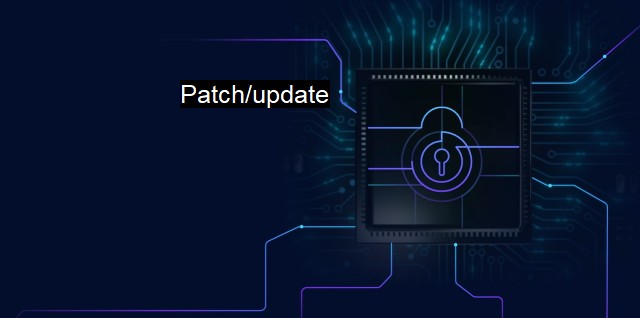What is Patch/update?
The Importance of Patches and Updates in Strengthening Computing Systems Against Cyber Threats: A Comprehensive Overview
A patch update may seem like a rather technical term, but its importance in cybersecurity and antivirus protection is undeniable. Simply put, a patch update is a piece of software designed to fix or improve a computer program or its supporting data. The need for a patch results from any software bug, a gap in security, or additional feature requirements. Patches are integral in improving usability, maintaining stability, and enhancing the security of software applications.Patch updates address security vulnerabilities. A software application, much like anything else, isn't flawless. Over time, cyber attackers spot weak points or 'vulnerabilities' in the software, upon which they build exploits to harm the system or to gain unauthorized access to sensitive data. Primarily, these vulnerabilities arise from coding errors made during software development.
Therefore, developers regularly inspect their software for potential weak points and create patches or modifications to the software's source code. They then package these patches into updates and deliver them to the software's users. By installing these patches or patch updates, users can rectify the identified security vulnerabilities, fortifying their systems against malware threats or data breaches.
In the antivirus realm, patches carry great significance as well. Antivirus software guards computer systems from malicious digital threats, such as viruses, worms, trojans, keyloggers, adware, and spyware, to name a few. The security landscape keeps thriving with new kinds of attacks, so antivirus software must consistently evolve through patch updates. This continuous evolution enables the antivirus algorithms to recognize and neutralize newly emergent threats. If antivirus software becomes outdated by not being patched, it tends to be less effective in detecting and thwarting the latest versions of digital malware.
A glaring example of the importance of patch updates materialized during the infamous WannaCry ransomware attack in 2017. This cyberattack targeted a vulnerability in the Microsoft Windows operating system, which Microsoft had previously identified and released a patch for. users who hadn't updated or 'patched up' their systems fell prey to the WannaCry attack and faced massive monetary losses and critical data breaches.
Despite their importance, patch updates often get neglected by end users, putting their cyber safety at stake. Some users defer these updates due to the sheer inconvenience, as the process may momentarily disrupt the typical computer use. The other reason is the lack of awareness about the updates' significance in reinforcing robust and secured system operations.
Courtesy of recent advances in technology, software developers are now offering 'automatic updates,’ where the patches seamlessly download and install in the background without interfering with the functioning of the system or other software applications. This automatic update feature ensures that every system stays up-to-date and adequately fortified against potential cyber threats.
Patch updates are vital in the world of cybersecurity and antivirus protection. They are tools wielded with finesse by software developers and antivirus programmers in the age-old tussle against cyber threats. One needs to approach patch updates seriously, understanding the enormous benefits those tiny software tweaks bring to maintaining system stability, adding new features, and, more importantly, keeping cyber-attacks at bay. In this digital era where cyber threats are relentless, staying lax about patch updates stands tantamount to inviting cyber trouble. As technology continues to gain ground, the urgency to keep software patched, more so than ever, is indeed one of the best lines of defenses against cybersecurity threats.

Patch/update FAQs
What is a patch/update in cybersecurity?
In cybersecurity, a patch or update refers to a software code change made to fix a security vulnerability, bug or to enhance the software features. An update may also include improved functionality, better performance, or new features that make the software more efficient or easier to use.Why is it important to install patches and updates for antivirus software?
It is essential to install patches and updates for antivirus software to keep the software up-to-date with the latest security threats and to ensure that the antivirus software can detect and remove the latest malware and viruses. Without regular updates, antivirus software will become ineffective in protecting your device from cyberthreats.What happens if I don't install the latest patches and updates for antivirus software?
If you don't install the latest patches and updates for antivirus software, your device will become vulnerable to cyber-attacks, and your personal data will be at risk of being stolen or compromised. Outdated antivirus software will not be able to detect the latest viruses and malware, leaving your device unprotected.How often should I install patches and updates for antivirus software?
It is recommended to install patches and updates for antivirus software as soon as they become available. These updates are usually released as soon as a vulnerability or security issue is discovered, so it's essential to install them promptly to protect your device from the latest cyber threats. Some antivirus software may have an automatic update feature that can install patches and updates automatically, ensuring that you always have up-to-date protection.Related Topics
Security patches Zero-day exploits Software updates Malware signatures Cybersecurity hygiene
| | A | | | B | | | C | | | D | | | E | | | F | | | G | | | H | | | I | | | J | | | K | | | L | | | M | |
| | N | | | O | | | P | | | Q | | | R | | | S | | | T | | | U | | | V | | | W | | | X | | | Y | | | Z | |
| | 1 | | | 2 | | | 3 | | | 4 | | | 7 | | | 8 | | |||||||